Effects of Pricing Strategies on Consumer Purchase Intentions: Aldi
VerifiedAdded on 2022/11/25
|23
|8739
|342
Report
AI Summary
This report examines the impact of pricing strategies on consumer purchase intentions within the UK grocery sector, using Aldi as a case study. It begins with an introduction to the topic, providing background information on the UK grocery market, the rise of Aldi, and the importance of pricing in marketing. The report outlines the research objectives, questions, and significance. The literature review explores various pricing strategies, including high-low pricing and everyday low pricing, and their influence on consumer behavior. The report further investigates the theoretical concepts of Adaptation-level theory, Signaling Theory and Theory of Reasoned Action. It details the research methodology, findings, and analysis, offering insights into how Aldi's pricing strategies have influenced consumer behavior and market share. The report concludes with recommendations for retail companies operating in the UK market, emphasizing the role of pricing strategies in gaining a competitive advantage. The report is organized into five chapters: introduction, literature review, research methodology, findings and analysis, and conclusion.
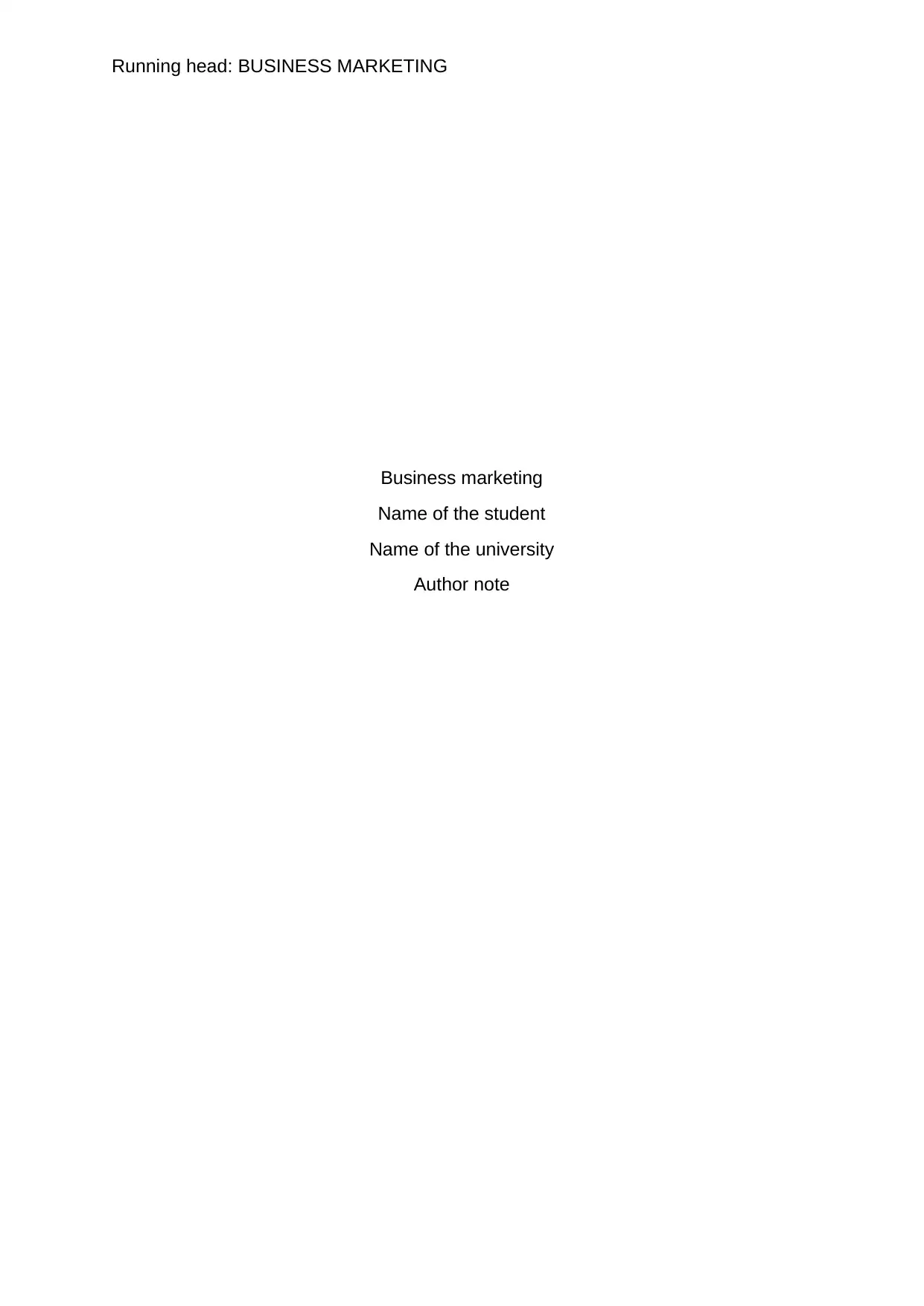
Running head: BUSINESS MARKETING
Business marketing
Name of the student
Name of the university
Author note
Business marketing
Name of the student
Name of the university
Author note
Paraphrase This Document
Need a fresh take? Get an instant paraphrase of this document with our AI Paraphraser
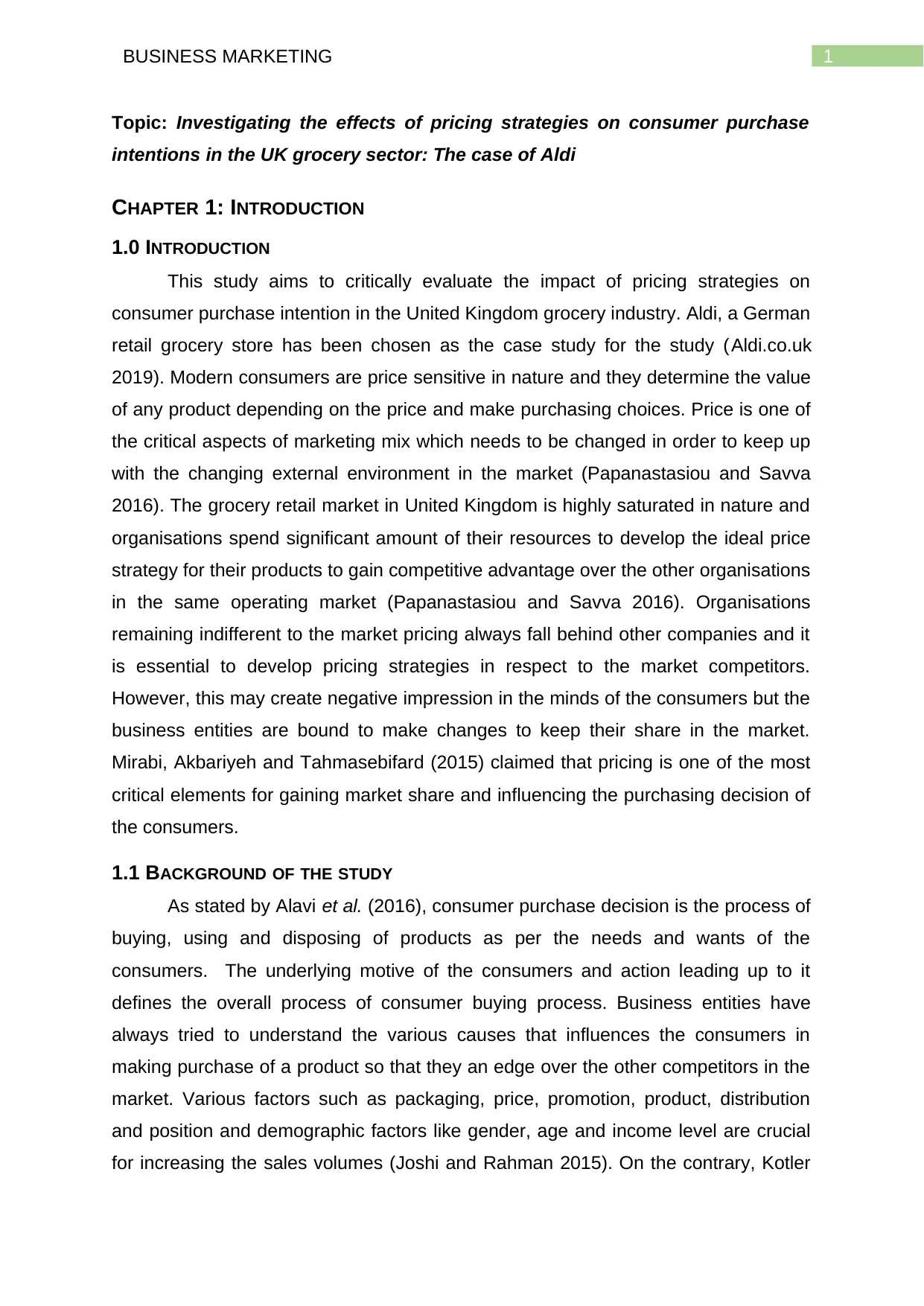
1BUSINESS MARKETING
Topic: Investigating the effects of pricing strategies on consumer purchase
intentions in the UK grocery sector: The case of Aldi
CHAPTER 1: INTRODUCTION
1.0 INTRODUCTION
This study aims to critically evaluate the impact of pricing strategies on
consumer purchase intention in the United Kingdom grocery industry. Aldi, a German
retail grocery store has been chosen as the case study for the study (Aldi.co.uk
2019). Modern consumers are price sensitive in nature and they determine the value
of any product depending on the price and make purchasing choices. Price is one of
the critical aspects of marketing mix which needs to be changed in order to keep up
with the changing external environment in the market (Papanastasiou and Savva
2016). The grocery retail market in United Kingdom is highly saturated in nature and
organisations spend significant amount of their resources to develop the ideal price
strategy for their products to gain competitive advantage over the other organisations
in the same operating market (Papanastasiou and Savva 2016). Organisations
remaining indifferent to the market pricing always fall behind other companies and it
is essential to develop pricing strategies in respect to the market competitors.
However, this may create negative impression in the minds of the consumers but the
business entities are bound to make changes to keep their share in the market.
Mirabi, Akbariyeh and Tahmasebifard (2015) claimed that pricing is one of the most
critical elements for gaining market share and influencing the purchasing decision of
the consumers.
1.1 BACKGROUND OF THE STUDY
As stated by Alavi et al. (2016), consumer purchase decision is the process of
buying, using and disposing of products as per the needs and wants of the
consumers. The underlying motive of the consumers and action leading up to it
defines the overall process of consumer buying process. Business entities have
always tried to understand the various causes that influences the consumers in
making purchase of a product so that they an edge over the other competitors in the
market. Various factors such as packaging, price, promotion, product, distribution
and position and demographic factors like gender, age and income level are crucial
for increasing the sales volumes (Joshi and Rahman 2015). On the contrary, Kotler
Topic: Investigating the effects of pricing strategies on consumer purchase
intentions in the UK grocery sector: The case of Aldi
CHAPTER 1: INTRODUCTION
1.0 INTRODUCTION
This study aims to critically evaluate the impact of pricing strategies on
consumer purchase intention in the United Kingdom grocery industry. Aldi, a German
retail grocery store has been chosen as the case study for the study (Aldi.co.uk
2019). Modern consumers are price sensitive in nature and they determine the value
of any product depending on the price and make purchasing choices. Price is one of
the critical aspects of marketing mix which needs to be changed in order to keep up
with the changing external environment in the market (Papanastasiou and Savva
2016). The grocery retail market in United Kingdom is highly saturated in nature and
organisations spend significant amount of their resources to develop the ideal price
strategy for their products to gain competitive advantage over the other organisations
in the same operating market (Papanastasiou and Savva 2016). Organisations
remaining indifferent to the market pricing always fall behind other companies and it
is essential to develop pricing strategies in respect to the market competitors.
However, this may create negative impression in the minds of the consumers but the
business entities are bound to make changes to keep their share in the market.
Mirabi, Akbariyeh and Tahmasebifard (2015) claimed that pricing is one of the most
critical elements for gaining market share and influencing the purchasing decision of
the consumers.
1.1 BACKGROUND OF THE STUDY
As stated by Alavi et al. (2016), consumer purchase decision is the process of
buying, using and disposing of products as per the needs and wants of the
consumers. The underlying motive of the consumers and action leading up to it
defines the overall process of consumer buying process. Business entities have
always tried to understand the various causes that influences the consumers in
making purchase of a product so that they an edge over the other competitors in the
market. Various factors such as packaging, price, promotion, product, distribution
and position and demographic factors like gender, age and income level are crucial
for increasing the sales volumes (Joshi and Rahman 2015). On the contrary, Kotler
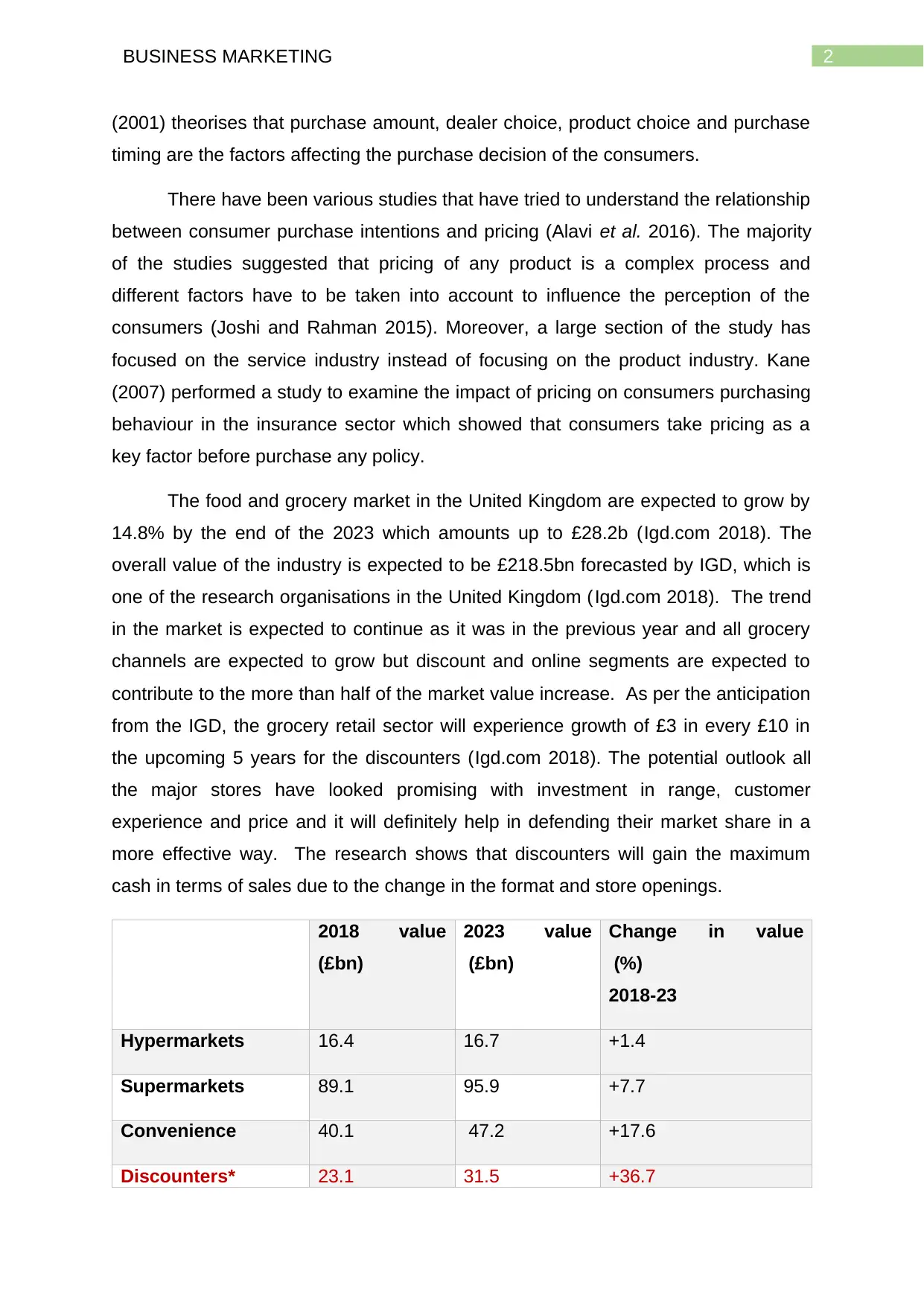
2BUSINESS MARKETING
(2001) theorises that purchase amount, dealer choice, product choice and purchase
timing are the factors affecting the purchase decision of the consumers.
There have been various studies that have tried to understand the relationship
between consumer purchase intentions and pricing (Alavi et al. 2016). The majority
of the studies suggested that pricing of any product is a complex process and
different factors have to be taken into account to influence the perception of the
consumers (Joshi and Rahman 2015). Moreover, a large section of the study has
focused on the service industry instead of focusing on the product industry. Kane
(2007) performed a study to examine the impact of pricing on consumers purchasing
behaviour in the insurance sector which showed that consumers take pricing as a
key factor before purchase any policy.
The food and grocery market in the United Kingdom are expected to grow by
14.8% by the end of the 2023 which amounts up to £28.2b (Igd.com 2018). The
overall value of the industry is expected to be £218.5bn forecasted by IGD, which is
one of the research organisations in the United Kingdom (Igd.com 2018). The trend
in the market is expected to continue as it was in the previous year and all grocery
channels are expected to grow but discount and online segments are expected to
contribute to the more than half of the market value increase. As per the anticipation
from the IGD, the grocery retail sector will experience growth of £3 in every £10 in
the upcoming 5 years for the discounters (Igd.com 2018). The potential outlook all
the major stores have looked promising with investment in range, customer
experience and price and it will definitely help in defending their market share in a
more effective way. The research shows that discounters will gain the maximum
cash in terms of sales due to the change in the format and store openings.
2018 value
(£bn)
2023 value
(£bn)
Change in value
(%)
2018-23
Hypermarkets 16.4 16.7 +1.4
Supermarkets 89.1 95.9 +7.7
Convenience 40.1 47.2 +17.6
Discounters* 23.1 31.5 +36.7
(2001) theorises that purchase amount, dealer choice, product choice and purchase
timing are the factors affecting the purchase decision of the consumers.
There have been various studies that have tried to understand the relationship
between consumer purchase intentions and pricing (Alavi et al. 2016). The majority
of the studies suggested that pricing of any product is a complex process and
different factors have to be taken into account to influence the perception of the
consumers (Joshi and Rahman 2015). Moreover, a large section of the study has
focused on the service industry instead of focusing on the product industry. Kane
(2007) performed a study to examine the impact of pricing on consumers purchasing
behaviour in the insurance sector which showed that consumers take pricing as a
key factor before purchase any policy.
The food and grocery market in the United Kingdom are expected to grow by
14.8% by the end of the 2023 which amounts up to £28.2b (Igd.com 2018). The
overall value of the industry is expected to be £218.5bn forecasted by IGD, which is
one of the research organisations in the United Kingdom (Igd.com 2018). The trend
in the market is expected to continue as it was in the previous year and all grocery
channels are expected to grow but discount and online segments are expected to
contribute to the more than half of the market value increase. As per the anticipation
from the IGD, the grocery retail sector will experience growth of £3 in every £10 in
the upcoming 5 years for the discounters (Igd.com 2018). The potential outlook all
the major stores have looked promising with investment in range, customer
experience and price and it will definitely help in defending their market share in a
more effective way. The research shows that discounters will gain the maximum
cash in terms of sales due to the change in the format and store openings.
2018 value
(£bn)
2023 value
(£bn)
Change in value
(%)
2018-23
Hypermarkets 16.4 16.7 +1.4
Supermarkets 89.1 95.9 +7.7
Convenience 40.1 47.2 +17.6
Discounters* 23.1 31.5 +36.7
⊘ This is a preview!⊘
Do you want full access?
Subscribe today to unlock all pages.

Trusted by 1+ million students worldwide
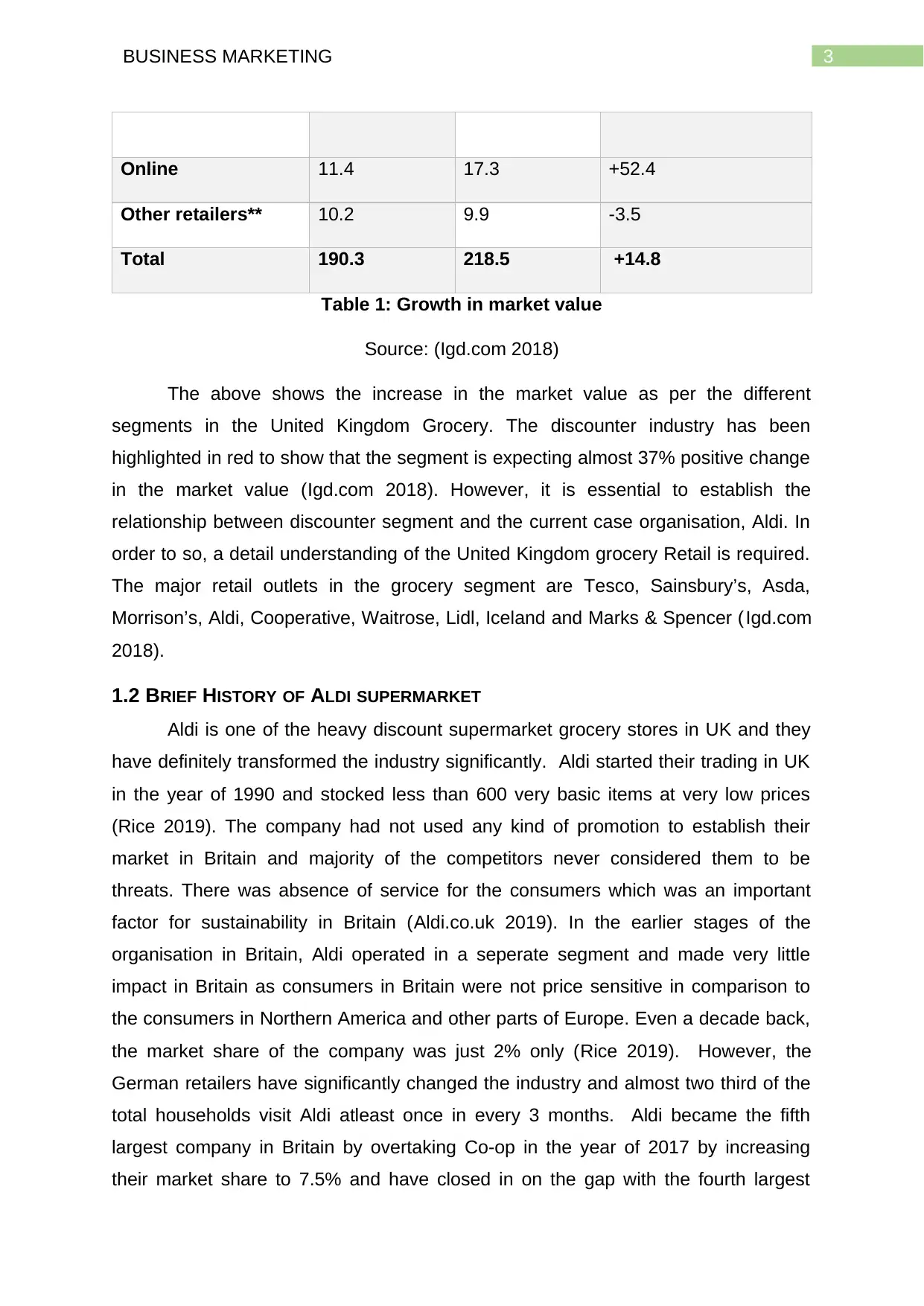
3BUSINESS MARKETING
Online 11.4 17.3 +52.4
Other retailers** 10.2 9.9 -3.5
Total 190.3 218.5 +14.8
Table 1: Growth in market value
Source: (Igd.com 2018)
The above shows the increase in the market value as per the different
segments in the United Kingdom Grocery. The discounter industry has been
highlighted in red to show that the segment is expecting almost 37% positive change
in the market value (Igd.com 2018). However, it is essential to establish the
relationship between discounter segment and the current case organisation, Aldi. In
order to so, a detail understanding of the United Kingdom grocery Retail is required.
The major retail outlets in the grocery segment are Tesco, Sainsbury’s, Asda,
Morrison’s, Aldi, Cooperative, Waitrose, Lidl, Iceland and Marks & Spencer (Igd.com
2018).
1.2 BRIEF HISTORY OF ALDI SUPERMARKET
Aldi is one of the heavy discount supermarket grocery stores in UK and they
have definitely transformed the industry significantly. Aldi started their trading in UK
in the year of 1990 and stocked less than 600 very basic items at very low prices
(Rice 2019). The company had not used any kind of promotion to establish their
market in Britain and majority of the competitors never considered them to be
threats. There was absence of service for the consumers which was an important
factor for sustainability in Britain (Aldi.co.uk 2019). In the earlier stages of the
organisation in Britain, Aldi operated in a seperate segment and made very little
impact in Britain as consumers in Britain were not price sensitive in comparison to
the consumers in Northern America and other parts of Europe. Even a decade back,
the market share of the company was just 2% only (Rice 2019). However, the
German retailers have significantly changed the industry and almost two third of the
total households visit Aldi atleast once in every 3 months. Aldi became the fifth
largest company in Britain by overtaking Co-op in the year of 2017 by increasing
their market share to 7.5% and have closed in on the gap with the fourth largest
Online 11.4 17.3 +52.4
Other retailers** 10.2 9.9 -3.5
Total 190.3 218.5 +14.8
Table 1: Growth in market value
Source: (Igd.com 2018)
The above shows the increase in the market value as per the different
segments in the United Kingdom Grocery. The discounter industry has been
highlighted in red to show that the segment is expecting almost 37% positive change
in the market value (Igd.com 2018). However, it is essential to establish the
relationship between discounter segment and the current case organisation, Aldi. In
order to so, a detail understanding of the United Kingdom grocery Retail is required.
The major retail outlets in the grocery segment are Tesco, Sainsbury’s, Asda,
Morrison’s, Aldi, Cooperative, Waitrose, Lidl, Iceland and Marks & Spencer (Igd.com
2018).
1.2 BRIEF HISTORY OF ALDI SUPERMARKET
Aldi is one of the heavy discount supermarket grocery stores in UK and they
have definitely transformed the industry significantly. Aldi started their trading in UK
in the year of 1990 and stocked less than 600 very basic items at very low prices
(Rice 2019). The company had not used any kind of promotion to establish their
market in Britain and majority of the competitors never considered them to be
threats. There was absence of service for the consumers which was an important
factor for sustainability in Britain (Aldi.co.uk 2019). In the earlier stages of the
organisation in Britain, Aldi operated in a seperate segment and made very little
impact in Britain as consumers in Britain were not price sensitive in comparison to
the consumers in Northern America and other parts of Europe. Even a decade back,
the market share of the company was just 2% only (Rice 2019). However, the
German retailers have significantly changed the industry and almost two third of the
total households visit Aldi atleast once in every 3 months. Aldi became the fifth
largest company in Britain by overtaking Co-op in the year of 2017 by increasing
their market share to 7.5% and have closed in on the gap with the fourth largest
Paraphrase This Document
Need a fresh take? Get an instant paraphrase of this document with our AI Paraphraser
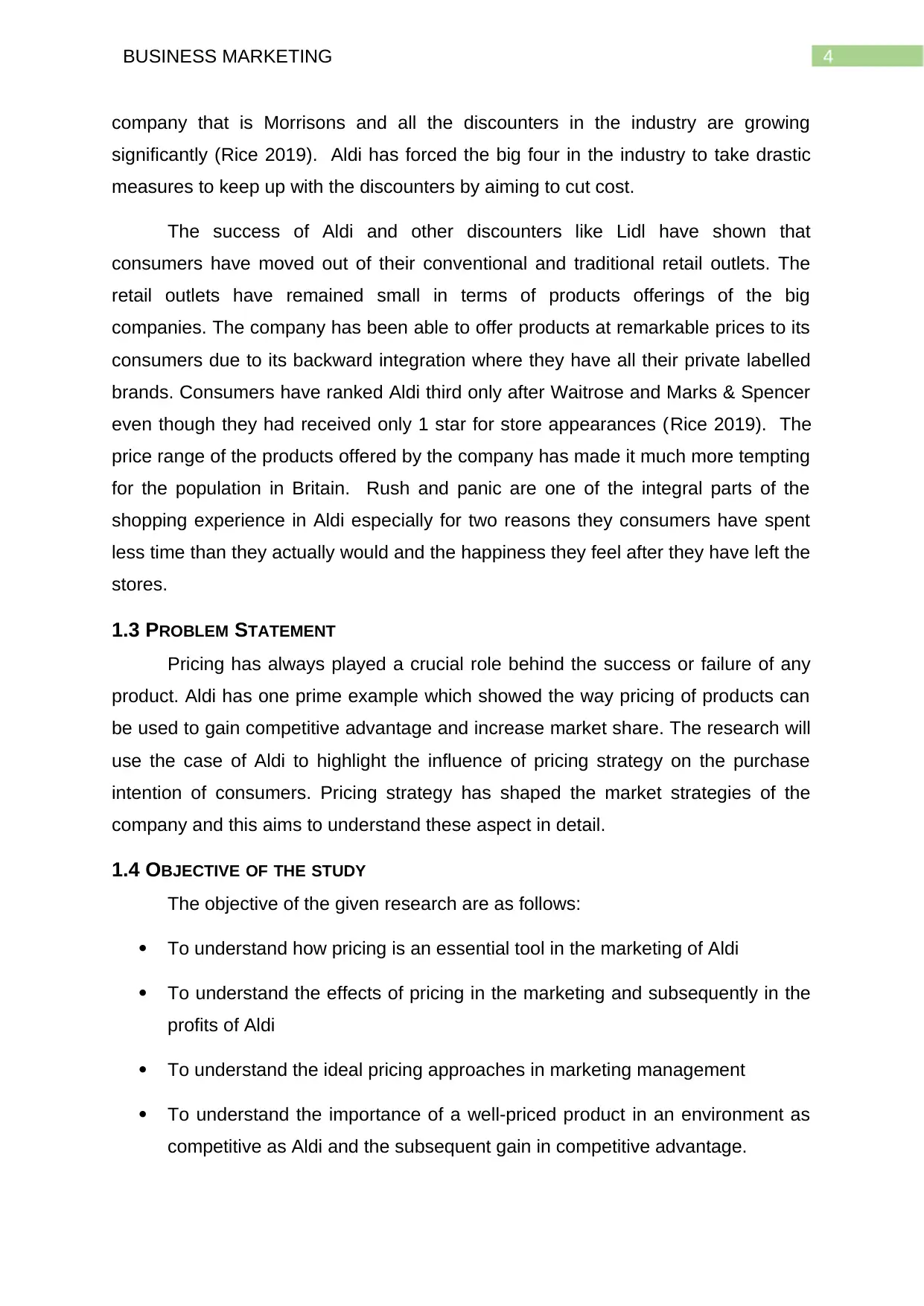
4BUSINESS MARKETING
company that is Morrisons and all the discounters in the industry are growing
significantly (Rice 2019). Aldi has forced the big four in the industry to take drastic
measures to keep up with the discounters by aiming to cut cost.
The success of Aldi and other discounters like Lidl have shown that
consumers have moved out of their conventional and traditional retail outlets. The
retail outlets have remained small in terms of products offerings of the big
companies. The company has been able to offer products at remarkable prices to its
consumers due to its backward integration where they have all their private labelled
brands. Consumers have ranked Aldi third only after Waitrose and Marks & Spencer
even though they had received only 1 star for store appearances (Rice 2019). The
price range of the products offered by the company has made it much more tempting
for the population in Britain. Rush and panic are one of the integral parts of the
shopping experience in Aldi especially for two reasons they consumers have spent
less time than they actually would and the happiness they feel after they have left the
stores.
1.3 PROBLEM STATEMENT
Pricing has always played a crucial role behind the success or failure of any
product. Aldi has one prime example which showed the way pricing of products can
be used to gain competitive advantage and increase market share. The research will
use the case of Aldi to highlight the influence of pricing strategy on the purchase
intention of consumers. Pricing strategy has shaped the market strategies of the
company and this aims to understand these aspect in detail.
1.4 OBJECTIVE OF THE STUDY
The objective of the given research are as follows:
To understand how pricing is an essential tool in the marketing of Aldi
To understand the effects of pricing in the marketing and subsequently in the
profits of Aldi
To understand the ideal pricing approaches in marketing management
To understand the importance of a well-priced product in an environment as
competitive as Aldi and the subsequent gain in competitive advantage.
company that is Morrisons and all the discounters in the industry are growing
significantly (Rice 2019). Aldi has forced the big four in the industry to take drastic
measures to keep up with the discounters by aiming to cut cost.
The success of Aldi and other discounters like Lidl have shown that
consumers have moved out of their conventional and traditional retail outlets. The
retail outlets have remained small in terms of products offerings of the big
companies. The company has been able to offer products at remarkable prices to its
consumers due to its backward integration where they have all their private labelled
brands. Consumers have ranked Aldi third only after Waitrose and Marks & Spencer
even though they had received only 1 star for store appearances (Rice 2019). The
price range of the products offered by the company has made it much more tempting
for the population in Britain. Rush and panic are one of the integral parts of the
shopping experience in Aldi especially for two reasons they consumers have spent
less time than they actually would and the happiness they feel after they have left the
stores.
1.3 PROBLEM STATEMENT
Pricing has always played a crucial role behind the success or failure of any
product. Aldi has one prime example which showed the way pricing of products can
be used to gain competitive advantage and increase market share. The research will
use the case of Aldi to highlight the influence of pricing strategy on the purchase
intention of consumers. Pricing strategy has shaped the market strategies of the
company and this aims to understand these aspect in detail.
1.4 OBJECTIVE OF THE STUDY
The objective of the given research are as follows:
To understand how pricing is an essential tool in the marketing of Aldi
To understand the effects of pricing in the marketing and subsequently in the
profits of Aldi
To understand the ideal pricing approaches in marketing management
To understand the importance of a well-priced product in an environment as
competitive as Aldi and the subsequent gain in competitive advantage.
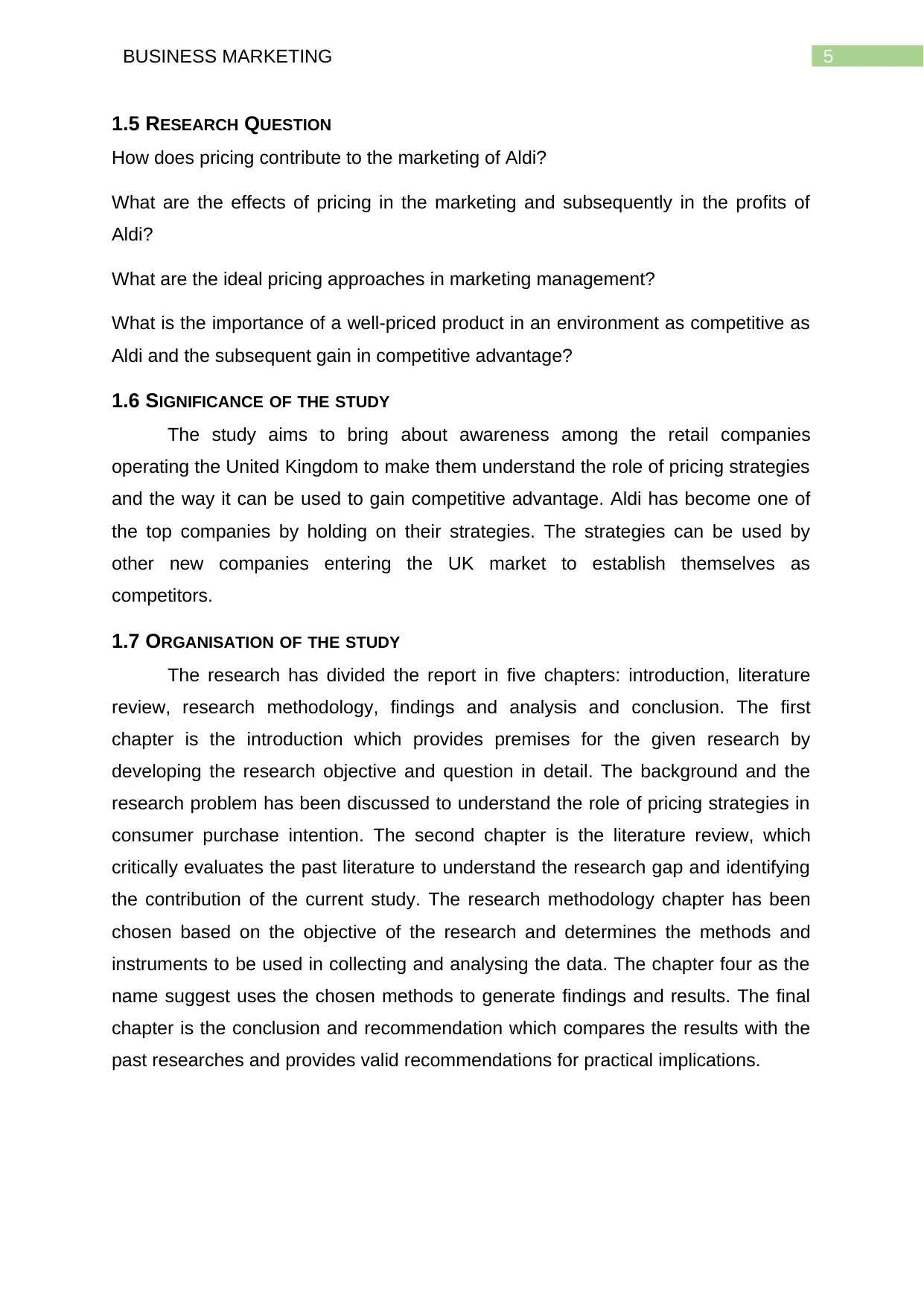
5BUSINESS MARKETING
1.5 RESEARCH QUESTION
How does pricing contribute to the marketing of Aldi?
What are the effects of pricing in the marketing and subsequently in the profits of
Aldi?
What are the ideal pricing approaches in marketing management?
What is the importance of a well-priced product in an environment as competitive as
Aldi and the subsequent gain in competitive advantage?
1.6 SIGNIFICANCE OF THE STUDY
The study aims to bring about awareness among the retail companies
operating the United Kingdom to make them understand the role of pricing strategies
and the way it can be used to gain competitive advantage. Aldi has become one of
the top companies by holding on their strategies. The strategies can be used by
other new companies entering the UK market to establish themselves as
competitors.
1.7 ORGANISATION OF THE STUDY
The research has divided the report in five chapters: introduction, literature
review, research methodology, findings and analysis and conclusion. The first
chapter is the introduction which provides premises for the given research by
developing the research objective and question in detail. The background and the
research problem has been discussed to understand the role of pricing strategies in
consumer purchase intention. The second chapter is the literature review, which
critically evaluates the past literature to understand the research gap and identifying
the contribution of the current study. The research methodology chapter has been
chosen based on the objective of the research and determines the methods and
instruments to be used in collecting and analysing the data. The chapter four as the
name suggest uses the chosen methods to generate findings and results. The final
chapter is the conclusion and recommendation which compares the results with the
past researches and provides valid recommendations for practical implications.
1.5 RESEARCH QUESTION
How does pricing contribute to the marketing of Aldi?
What are the effects of pricing in the marketing and subsequently in the profits of
Aldi?
What are the ideal pricing approaches in marketing management?
What is the importance of a well-priced product in an environment as competitive as
Aldi and the subsequent gain in competitive advantage?
1.6 SIGNIFICANCE OF THE STUDY
The study aims to bring about awareness among the retail companies
operating the United Kingdom to make them understand the role of pricing strategies
and the way it can be used to gain competitive advantage. Aldi has become one of
the top companies by holding on their strategies. The strategies can be used by
other new companies entering the UK market to establish themselves as
competitors.
1.7 ORGANISATION OF THE STUDY
The research has divided the report in five chapters: introduction, literature
review, research methodology, findings and analysis and conclusion. The first
chapter is the introduction which provides premises for the given research by
developing the research objective and question in detail. The background and the
research problem has been discussed to understand the role of pricing strategies in
consumer purchase intention. The second chapter is the literature review, which
critically evaluates the past literature to understand the research gap and identifying
the contribution of the current study. The research methodology chapter has been
chosen based on the objective of the research and determines the methods and
instruments to be used in collecting and analysing the data. The chapter four as the
name suggest uses the chosen methods to generate findings and results. The final
chapter is the conclusion and recommendation which compares the results with the
past researches and provides valid recommendations for practical implications.
⊘ This is a preview!⊘
Do you want full access?
Subscribe today to unlock all pages.

Trusted by 1+ million students worldwide
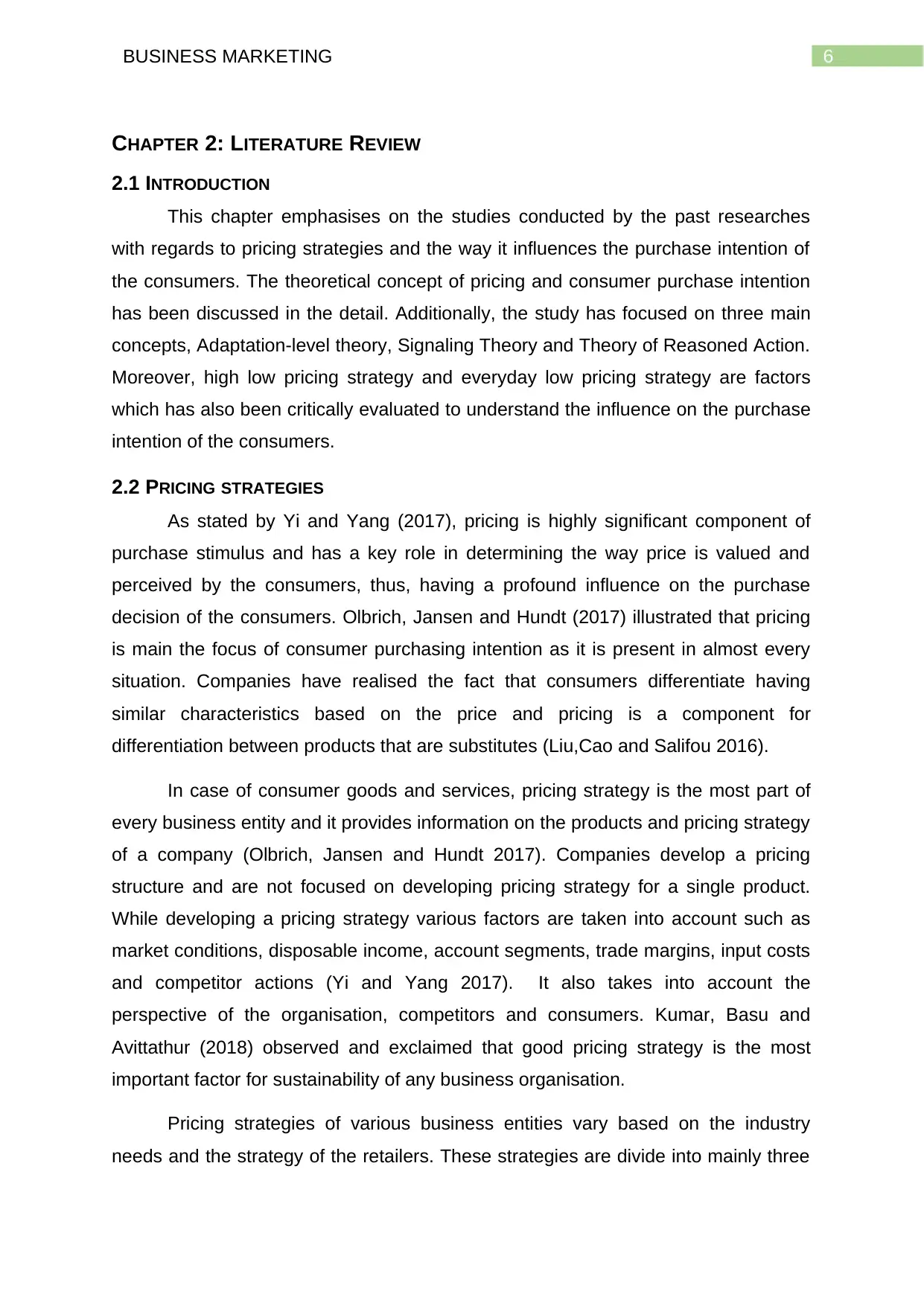
6BUSINESS MARKETING
CHAPTER 2: LITERATURE REVIEW
2.1 INTRODUCTION
This chapter emphasises on the studies conducted by the past researches
with regards to pricing strategies and the way it influences the purchase intention of
the consumers. The theoretical concept of pricing and consumer purchase intention
has been discussed in the detail. Additionally, the study has focused on three main
concepts, Adaptation-level theory, Signaling Theory and Theory of Reasoned Action.
Moreover, high low pricing strategy and everyday low pricing strategy are factors
which has also been critically evaluated to understand the influence on the purchase
intention of the consumers.
2.2 PRICING STRATEGIES
As stated by Yi and Yang (2017), pricing is highly significant component of
purchase stimulus and has a key role in determining the way price is valued and
perceived by the consumers, thus, having a profound influence on the purchase
decision of the consumers. Olbrich, Jansen and Hundt (2017) illustrated that pricing
is main the focus of consumer purchasing intention as it is present in almost every
situation. Companies have realised the fact that consumers differentiate having
similar characteristics based on the price and pricing is a component for
differentiation between products that are substitutes (Liu,Cao and Salifou 2016).
In case of consumer goods and services, pricing strategy is the most part of
every business entity and it provides information on the products and pricing strategy
of a company (Olbrich, Jansen and Hundt 2017). Companies develop a pricing
structure and are not focused on developing pricing strategy for a single product.
While developing a pricing strategy various factors are taken into account such as
market conditions, disposable income, account segments, trade margins, input costs
and competitor actions (Yi and Yang 2017). It also takes into account the
perspective of the organisation, competitors and consumers. Kumar, Basu and
Avittathur (2018) observed and exclaimed that good pricing strategy is the most
important factor for sustainability of any business organisation.
Pricing strategies of various business entities vary based on the industry
needs and the strategy of the retailers. These strategies are divide into mainly three
CHAPTER 2: LITERATURE REVIEW
2.1 INTRODUCTION
This chapter emphasises on the studies conducted by the past researches
with regards to pricing strategies and the way it influences the purchase intention of
the consumers. The theoretical concept of pricing and consumer purchase intention
has been discussed in the detail. Additionally, the study has focused on three main
concepts, Adaptation-level theory, Signaling Theory and Theory of Reasoned Action.
Moreover, high low pricing strategy and everyday low pricing strategy are factors
which has also been critically evaluated to understand the influence on the purchase
intention of the consumers.
2.2 PRICING STRATEGIES
As stated by Yi and Yang (2017), pricing is highly significant component of
purchase stimulus and has a key role in determining the way price is valued and
perceived by the consumers, thus, having a profound influence on the purchase
decision of the consumers. Olbrich, Jansen and Hundt (2017) illustrated that pricing
is main the focus of consumer purchasing intention as it is present in almost every
situation. Companies have realised the fact that consumers differentiate having
similar characteristics based on the price and pricing is a component for
differentiation between products that are substitutes (Liu,Cao and Salifou 2016).
In case of consumer goods and services, pricing strategy is the most part of
every business entity and it provides information on the products and pricing strategy
of a company (Olbrich, Jansen and Hundt 2017). Companies develop a pricing
structure and are not focused on developing pricing strategy for a single product.
While developing a pricing strategy various factors are taken into account such as
market conditions, disposable income, account segments, trade margins, input costs
and competitor actions (Yi and Yang 2017). It also takes into account the
perspective of the organisation, competitors and consumers. Kumar, Basu and
Avittathur (2018) observed and exclaimed that good pricing strategy is the most
important factor for sustainability of any business organisation.
Pricing strategies of various business entities vary based on the industry
needs and the strategy of the retailers. These strategies are divide into mainly three
Paraphrase This Document
Need a fresh take? Get an instant paraphrase of this document with our AI Paraphraser
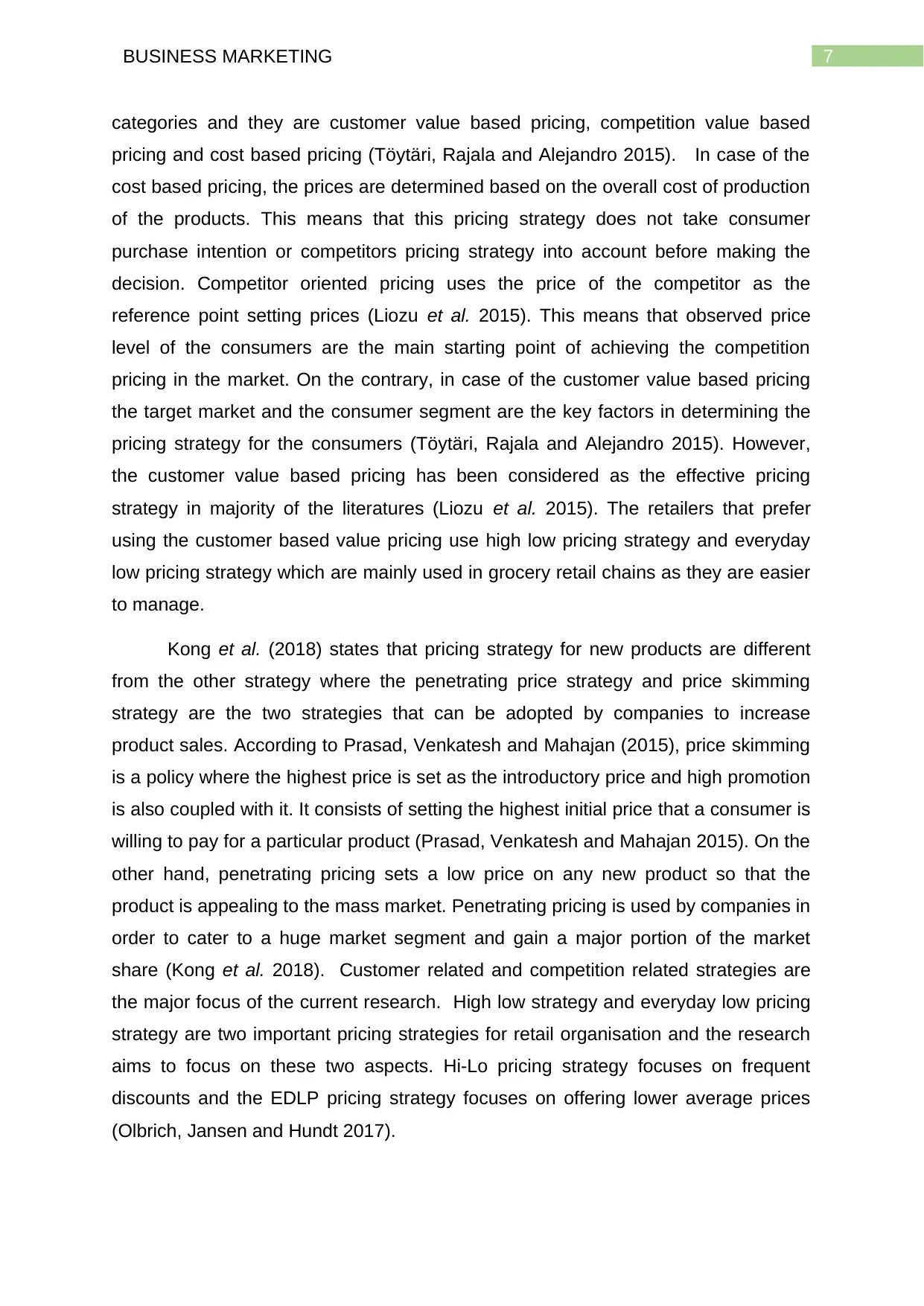
7BUSINESS MARKETING
categories and they are customer value based pricing, competition value based
pricing and cost based pricing (Töytäri, Rajala and Alejandro 2015). In case of the
cost based pricing, the prices are determined based on the overall cost of production
of the products. This means that this pricing strategy does not take consumer
purchase intention or competitors pricing strategy into account before making the
decision. Competitor oriented pricing uses the price of the competitor as the
reference point setting prices (Liozu et al. 2015). This means that observed price
level of the consumers are the main starting point of achieving the competition
pricing in the market. On the contrary, in case of the customer value based pricing
the target market and the consumer segment are the key factors in determining the
pricing strategy for the consumers (Töytäri, Rajala and Alejandro 2015). However,
the customer value based pricing has been considered as the effective pricing
strategy in majority of the literatures (Liozu et al. 2015). The retailers that prefer
using the customer based value pricing use high low pricing strategy and everyday
low pricing strategy which are mainly used in grocery retail chains as they are easier
to manage.
Kong et al. (2018) states that pricing strategy for new products are different
from the other strategy where the penetrating price strategy and price skimming
strategy are the two strategies that can be adopted by companies to increase
product sales. According to Prasad, Venkatesh and Mahajan (2015), price skimming
is a policy where the highest price is set as the introductory price and high promotion
is also coupled with it. It consists of setting the highest initial price that a consumer is
willing to pay for a particular product (Prasad, Venkatesh and Mahajan 2015). On the
other hand, penetrating pricing sets a low price on any new product so that the
product is appealing to the mass market. Penetrating pricing is used by companies in
order to cater to a huge market segment and gain a major portion of the market
share (Kong et al. 2018). Customer related and competition related strategies are
the major focus of the current research. High low strategy and everyday low pricing
strategy are two important pricing strategies for retail organisation and the research
aims to focus on these two aspects. Hi-Lo pricing strategy focuses on frequent
discounts and the EDLP pricing strategy focuses on offering lower average prices
(Olbrich, Jansen and Hundt 2017).
categories and they are customer value based pricing, competition value based
pricing and cost based pricing (Töytäri, Rajala and Alejandro 2015). In case of the
cost based pricing, the prices are determined based on the overall cost of production
of the products. This means that this pricing strategy does not take consumer
purchase intention or competitors pricing strategy into account before making the
decision. Competitor oriented pricing uses the price of the competitor as the
reference point setting prices (Liozu et al. 2015). This means that observed price
level of the consumers are the main starting point of achieving the competition
pricing in the market. On the contrary, in case of the customer value based pricing
the target market and the consumer segment are the key factors in determining the
pricing strategy for the consumers (Töytäri, Rajala and Alejandro 2015). However,
the customer value based pricing has been considered as the effective pricing
strategy in majority of the literatures (Liozu et al. 2015). The retailers that prefer
using the customer based value pricing use high low pricing strategy and everyday
low pricing strategy which are mainly used in grocery retail chains as they are easier
to manage.
Kong et al. (2018) states that pricing strategy for new products are different
from the other strategy where the penetrating price strategy and price skimming
strategy are the two strategies that can be adopted by companies to increase
product sales. According to Prasad, Venkatesh and Mahajan (2015), price skimming
is a policy where the highest price is set as the introductory price and high promotion
is also coupled with it. It consists of setting the highest initial price that a consumer is
willing to pay for a particular product (Prasad, Venkatesh and Mahajan 2015). On the
other hand, penetrating pricing sets a low price on any new product so that the
product is appealing to the mass market. Penetrating pricing is used by companies in
order to cater to a huge market segment and gain a major portion of the market
share (Kong et al. 2018). Customer related and competition related strategies are
the major focus of the current research. High low strategy and everyday low pricing
strategy are two important pricing strategies for retail organisation and the research
aims to focus on these two aspects. Hi-Lo pricing strategy focuses on frequent
discounts and the EDLP pricing strategy focuses on offering lower average prices
(Olbrich, Jansen and Hundt 2017).
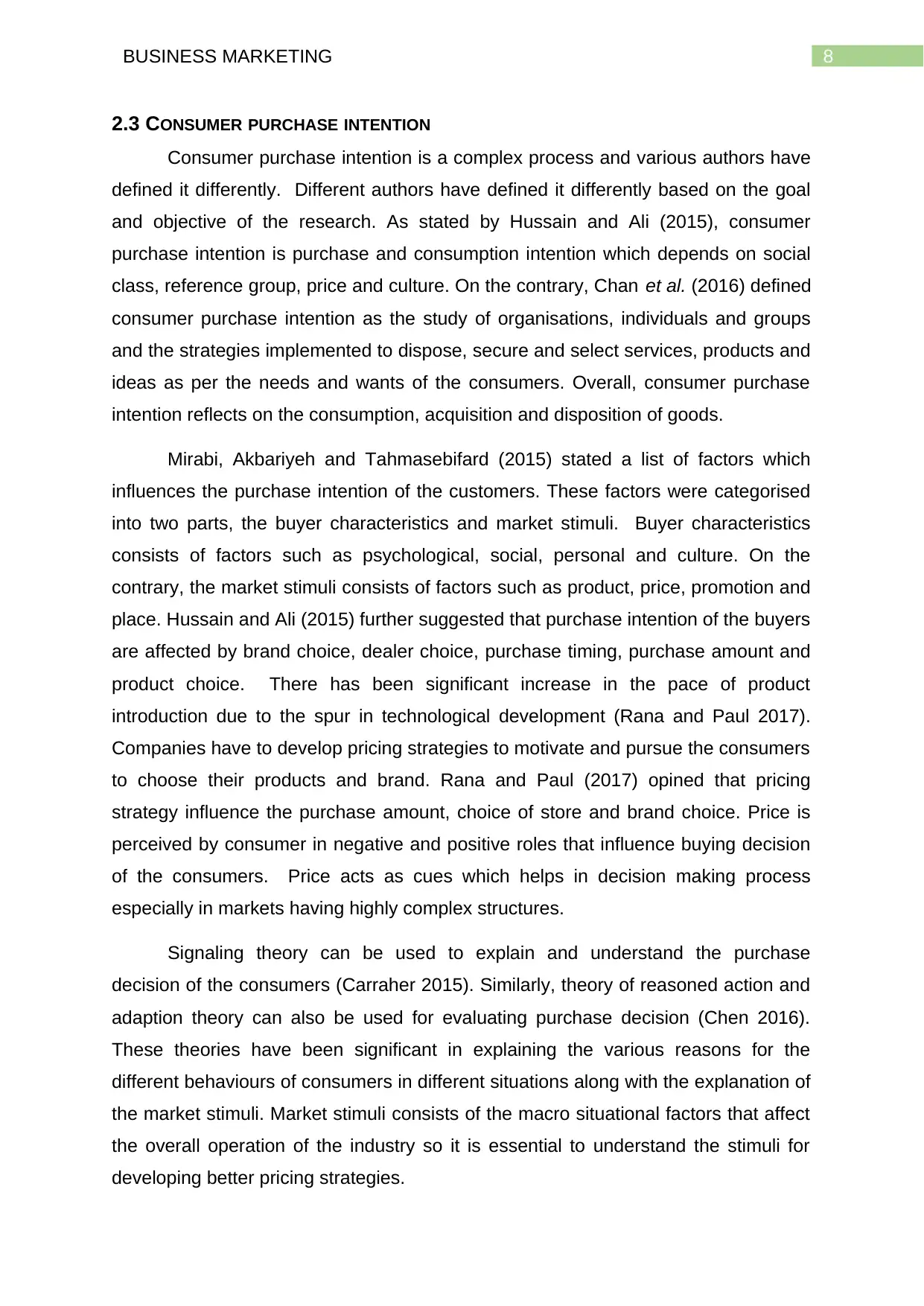
8BUSINESS MARKETING
2.3 CONSUMER PURCHASE INTENTION
Consumer purchase intention is a complex process and various authors have
defined it differently. Different authors have defined it differently based on the goal
and objective of the research. As stated by Hussain and Ali (2015), consumer
purchase intention is purchase and consumption intention which depends on social
class, reference group, price and culture. On the contrary, Chan et al. (2016) defined
consumer purchase intention as the study of organisations, individuals and groups
and the strategies implemented to dispose, secure and select services, products and
ideas as per the needs and wants of the consumers. Overall, consumer purchase
intention reflects on the consumption, acquisition and disposition of goods.
Mirabi, Akbariyeh and Tahmasebifard (2015) stated a list of factors which
influences the purchase intention of the customers. These factors were categorised
into two parts, the buyer characteristics and market stimuli. Buyer characteristics
consists of factors such as psychological, social, personal and culture. On the
contrary, the market stimuli consists of factors such as product, price, promotion and
place. Hussain and Ali (2015) further suggested that purchase intention of the buyers
are affected by brand choice, dealer choice, purchase timing, purchase amount and
product choice. There has been significant increase in the pace of product
introduction due to the spur in technological development (Rana and Paul 2017).
Companies have to develop pricing strategies to motivate and pursue the consumers
to choose their products and brand. Rana and Paul (2017) opined that pricing
strategy influence the purchase amount, choice of store and brand choice. Price is
perceived by consumer in negative and positive roles that influence buying decision
of the consumers. Price acts as cues which helps in decision making process
especially in markets having highly complex structures.
Signaling theory can be used to explain and understand the purchase
decision of the consumers (Carraher 2015). Similarly, theory of reasoned action and
adaption theory can also be used for evaluating purchase decision (Chen 2016).
These theories have been significant in explaining the various reasons for the
different behaviours of consumers in different situations along with the explanation of
the market stimuli. Market stimuli consists of the macro situational factors that affect
the overall operation of the industry so it is essential to understand the stimuli for
developing better pricing strategies.
2.3 CONSUMER PURCHASE INTENTION
Consumer purchase intention is a complex process and various authors have
defined it differently. Different authors have defined it differently based on the goal
and objective of the research. As stated by Hussain and Ali (2015), consumer
purchase intention is purchase and consumption intention which depends on social
class, reference group, price and culture. On the contrary, Chan et al. (2016) defined
consumer purchase intention as the study of organisations, individuals and groups
and the strategies implemented to dispose, secure and select services, products and
ideas as per the needs and wants of the consumers. Overall, consumer purchase
intention reflects on the consumption, acquisition and disposition of goods.
Mirabi, Akbariyeh and Tahmasebifard (2015) stated a list of factors which
influences the purchase intention of the customers. These factors were categorised
into two parts, the buyer characteristics and market stimuli. Buyer characteristics
consists of factors such as psychological, social, personal and culture. On the
contrary, the market stimuli consists of factors such as product, price, promotion and
place. Hussain and Ali (2015) further suggested that purchase intention of the buyers
are affected by brand choice, dealer choice, purchase timing, purchase amount and
product choice. There has been significant increase in the pace of product
introduction due to the spur in technological development (Rana and Paul 2017).
Companies have to develop pricing strategies to motivate and pursue the consumers
to choose their products and brand. Rana and Paul (2017) opined that pricing
strategy influence the purchase amount, choice of store and brand choice. Price is
perceived by consumer in negative and positive roles that influence buying decision
of the consumers. Price acts as cues which helps in decision making process
especially in markets having highly complex structures.
Signaling theory can be used to explain and understand the purchase
decision of the consumers (Carraher 2015). Similarly, theory of reasoned action and
adaption theory can also be used for evaluating purchase decision (Chen 2016).
These theories have been significant in explaining the various reasons for the
different behaviours of consumers in different situations along with the explanation of
the market stimuli. Market stimuli consists of the macro situational factors that affect
the overall operation of the industry so it is essential to understand the stimuli for
developing better pricing strategies.
⊘ This is a preview!⊘
Do you want full access?
Subscribe today to unlock all pages.

Trusted by 1+ million students worldwide
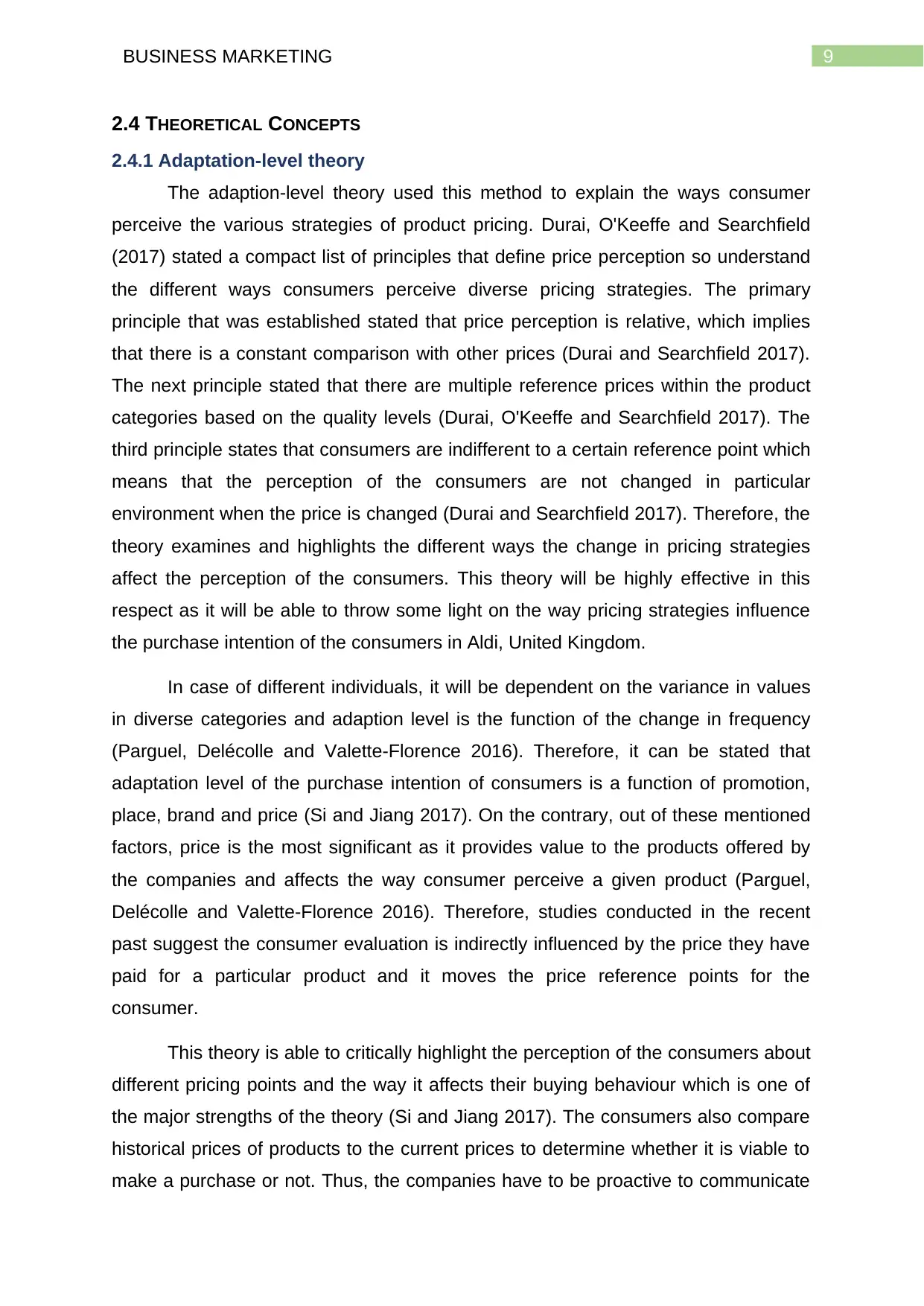
9BUSINESS MARKETING
2.4 THEORETICAL CONCEPTS
2.4.1 Adaptation-level theory
The adaption-level theory used this method to explain the ways consumer
perceive the various strategies of product pricing. Durai, O'Keeffe and Searchfield
(2017) stated a compact list of principles that define price perception so understand
the different ways consumers perceive diverse pricing strategies. The primary
principle that was established stated that price perception is relative, which implies
that there is a constant comparison with other prices (Durai and Searchfield 2017).
The next principle stated that there are multiple reference prices within the product
categories based on the quality levels (Durai, O'Keeffe and Searchfield 2017). The
third principle states that consumers are indifferent to a certain reference point which
means that the perception of the consumers are not changed in particular
environment when the price is changed (Durai and Searchfield 2017). Therefore, the
theory examines and highlights the different ways the change in pricing strategies
affect the perception of the consumers. This theory will be highly effective in this
respect as it will be able to throw some light on the way pricing strategies influence
the purchase intention of the consumers in Aldi, United Kingdom.
In case of different individuals, it will be dependent on the variance in values
in diverse categories and adaption level is the function of the change in frequency
(Parguel, Delécolle and Valette-Florence 2016). Therefore, it can be stated that
adaptation level of the purchase intention of consumers is a function of promotion,
place, brand and price (Si and Jiang 2017). On the contrary, out of these mentioned
factors, price is the most significant as it provides value to the products offered by
the companies and affects the way consumer perceive a given product (Parguel,
Delécolle and Valette-Florence 2016). Therefore, studies conducted in the recent
past suggest the consumer evaluation is indirectly influenced by the price they have
paid for a particular product and it moves the price reference points for the
consumer.
This theory is able to critically highlight the perception of the consumers about
different pricing points and the way it affects their buying behaviour which is one of
the major strengths of the theory (Si and Jiang 2017). The consumers also compare
historical prices of products to the current prices to determine whether it is viable to
make a purchase or not. Thus, the companies have to be proactive to communicate
2.4 THEORETICAL CONCEPTS
2.4.1 Adaptation-level theory
The adaption-level theory used this method to explain the ways consumer
perceive the various strategies of product pricing. Durai, O'Keeffe and Searchfield
(2017) stated a compact list of principles that define price perception so understand
the different ways consumers perceive diverse pricing strategies. The primary
principle that was established stated that price perception is relative, which implies
that there is a constant comparison with other prices (Durai and Searchfield 2017).
The next principle stated that there are multiple reference prices within the product
categories based on the quality levels (Durai, O'Keeffe and Searchfield 2017). The
third principle states that consumers are indifferent to a certain reference point which
means that the perception of the consumers are not changed in particular
environment when the price is changed (Durai and Searchfield 2017). Therefore, the
theory examines and highlights the different ways the change in pricing strategies
affect the perception of the consumers. This theory will be highly effective in this
respect as it will be able to throw some light on the way pricing strategies influence
the purchase intention of the consumers in Aldi, United Kingdom.
In case of different individuals, it will be dependent on the variance in values
in diverse categories and adaption level is the function of the change in frequency
(Parguel, Delécolle and Valette-Florence 2016). Therefore, it can be stated that
adaptation level of the purchase intention of consumers is a function of promotion,
place, brand and price (Si and Jiang 2017). On the contrary, out of these mentioned
factors, price is the most significant as it provides value to the products offered by
the companies and affects the way consumer perceive a given product (Parguel,
Delécolle and Valette-Florence 2016). Therefore, studies conducted in the recent
past suggest the consumer evaluation is indirectly influenced by the price they have
paid for a particular product and it moves the price reference points for the
consumer.
This theory is able to critically highlight the perception of the consumers about
different pricing points and the way it affects their buying behaviour which is one of
the major strengths of the theory (Si and Jiang 2017). The consumers also compare
historical prices of products to the current prices to determine whether it is viable to
make a purchase or not. Thus, the companies have to be proactive to communicate
Paraphrase This Document
Need a fresh take? Get an instant paraphrase of this document with our AI Paraphraser
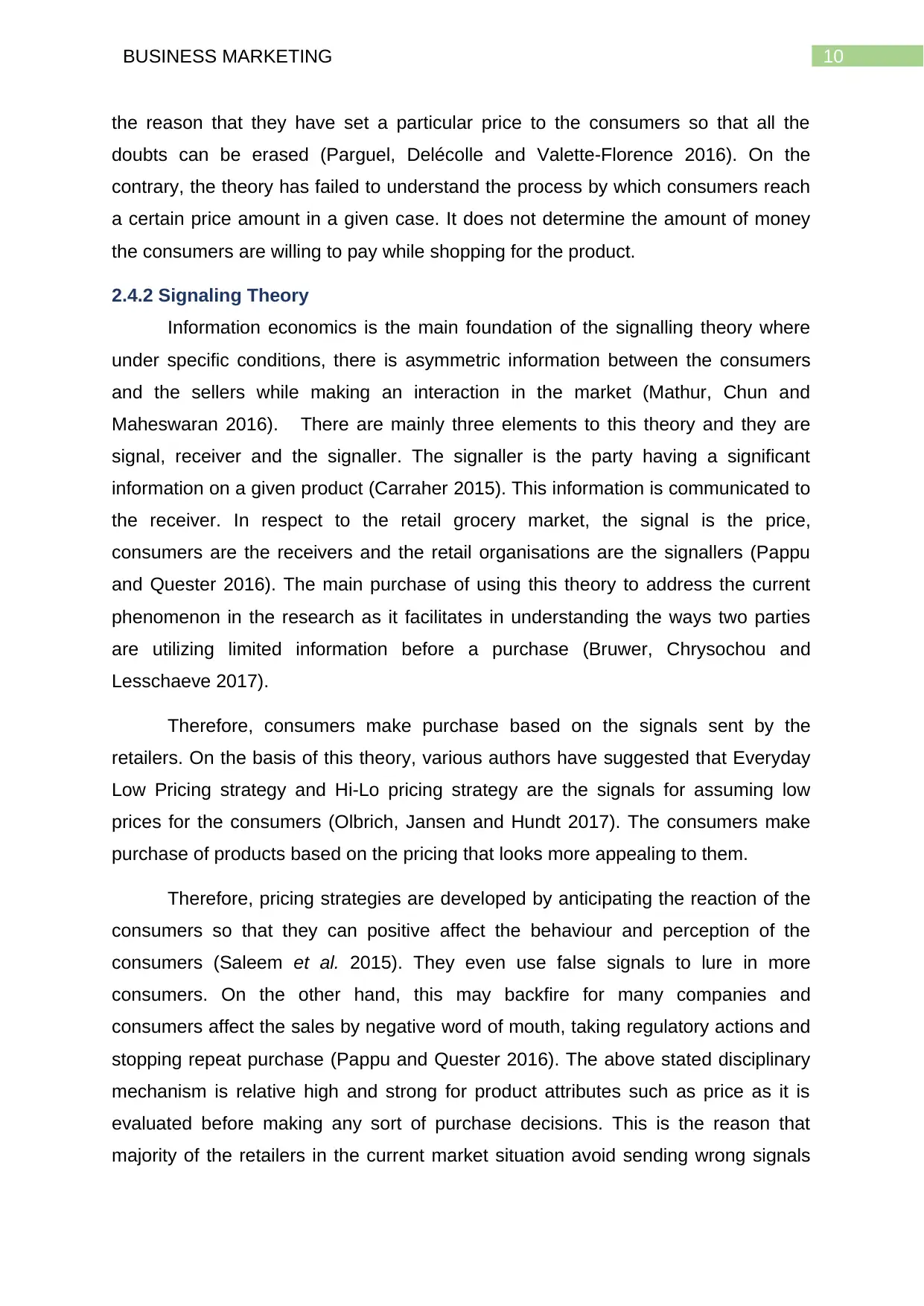
10BUSINESS MARKETING
the reason that they have set a particular price to the consumers so that all the
doubts can be erased (Parguel, Delécolle and Valette-Florence 2016). On the
contrary, the theory has failed to understand the process by which consumers reach
a certain price amount in a given case. It does not determine the amount of money
the consumers are willing to pay while shopping for the product.
2.4.2 Signaling Theory
Information economics is the main foundation of the signalling theory where
under specific conditions, there is asymmetric information between the consumers
and the sellers while making an interaction in the market (Mathur, Chun and
Maheswaran 2016). There are mainly three elements to this theory and they are
signal, receiver and the signaller. The signaller is the party having a significant
information on a given product (Carraher 2015). This information is communicated to
the receiver. In respect to the retail grocery market, the signal is the price,
consumers are the receivers and the retail organisations are the signallers (Pappu
and Quester 2016). The main purchase of using this theory to address the current
phenomenon in the research as it facilitates in understanding the ways two parties
are utilizing limited information before a purchase (Bruwer, Chrysochou and
Lesschaeve 2017).
Therefore, consumers make purchase based on the signals sent by the
retailers. On the basis of this theory, various authors have suggested that Everyday
Low Pricing strategy and Hi-Lo pricing strategy are the signals for assuming low
prices for the consumers (Olbrich, Jansen and Hundt 2017). The consumers make
purchase of products based on the pricing that looks more appealing to them.
Therefore, pricing strategies are developed by anticipating the reaction of the
consumers so that they can positive affect the behaviour and perception of the
consumers (Saleem et al. 2015). They even use false signals to lure in more
consumers. On the other hand, this may backfire for many companies and
consumers affect the sales by negative word of mouth, taking regulatory actions and
stopping repeat purchase (Pappu and Quester 2016). The above stated disciplinary
mechanism is relative high and strong for product attributes such as price as it is
evaluated before making any sort of purchase decisions. This is the reason that
majority of the retailers in the current market situation avoid sending wrong signals
the reason that they have set a particular price to the consumers so that all the
doubts can be erased (Parguel, Delécolle and Valette-Florence 2016). On the
contrary, the theory has failed to understand the process by which consumers reach
a certain price amount in a given case. It does not determine the amount of money
the consumers are willing to pay while shopping for the product.
2.4.2 Signaling Theory
Information economics is the main foundation of the signalling theory where
under specific conditions, there is asymmetric information between the consumers
and the sellers while making an interaction in the market (Mathur, Chun and
Maheswaran 2016). There are mainly three elements to this theory and they are
signal, receiver and the signaller. The signaller is the party having a significant
information on a given product (Carraher 2015). This information is communicated to
the receiver. In respect to the retail grocery market, the signal is the price,
consumers are the receivers and the retail organisations are the signallers (Pappu
and Quester 2016). The main purchase of using this theory to address the current
phenomenon in the research as it facilitates in understanding the ways two parties
are utilizing limited information before a purchase (Bruwer, Chrysochou and
Lesschaeve 2017).
Therefore, consumers make purchase based on the signals sent by the
retailers. On the basis of this theory, various authors have suggested that Everyday
Low Pricing strategy and Hi-Lo pricing strategy are the signals for assuming low
prices for the consumers (Olbrich, Jansen and Hundt 2017). The consumers make
purchase of products based on the pricing that looks more appealing to them.
Therefore, pricing strategies are developed by anticipating the reaction of the
consumers so that they can positive affect the behaviour and perception of the
consumers (Saleem et al. 2015). They even use false signals to lure in more
consumers. On the other hand, this may backfire for many companies and
consumers affect the sales by negative word of mouth, taking regulatory actions and
stopping repeat purchase (Pappu and Quester 2016). The above stated disciplinary
mechanism is relative high and strong for product attributes such as price as it is
evaluated before making any sort of purchase decisions. This is the reason that
majority of the retailers in the current market situation avoid sending wrong signals
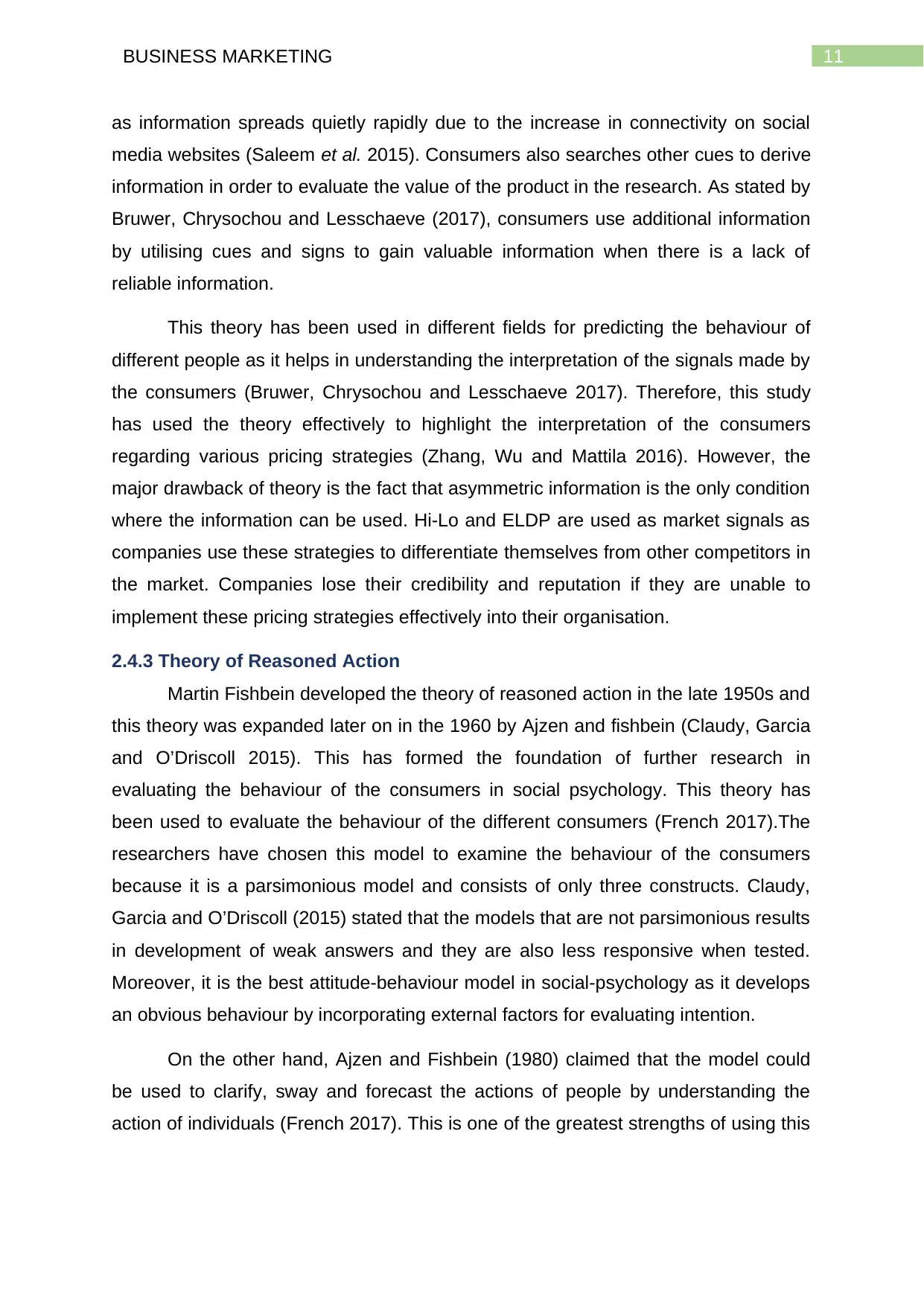
11BUSINESS MARKETING
as information spreads quietly rapidly due to the increase in connectivity on social
media websites (Saleem et al. 2015). Consumers also searches other cues to derive
information in order to evaluate the value of the product in the research. As stated by
Bruwer, Chrysochou and Lesschaeve (2017), consumers use additional information
by utilising cues and signs to gain valuable information when there is a lack of
reliable information.
This theory has been used in different fields for predicting the behaviour of
different people as it helps in understanding the interpretation of the signals made by
the consumers (Bruwer, Chrysochou and Lesschaeve 2017). Therefore, this study
has used the theory effectively to highlight the interpretation of the consumers
regarding various pricing strategies (Zhang, Wu and Mattila 2016). However, the
major drawback of theory is the fact that asymmetric information is the only condition
where the information can be used. Hi-Lo and ELDP are used as market signals as
companies use these strategies to differentiate themselves from other competitors in
the market. Companies lose their credibility and reputation if they are unable to
implement these pricing strategies effectively into their organisation.
2.4.3 Theory of Reasoned Action
Martin Fishbein developed the theory of reasoned action in the late 1950s and
this theory was expanded later on in the 1960 by Ajzen and fishbein (Claudy, Garcia
and O’Driscoll 2015). This has formed the foundation of further research in
evaluating the behaviour of the consumers in social psychology. This theory has
been used to evaluate the behaviour of the different consumers (French 2017).The
researchers have chosen this model to examine the behaviour of the consumers
because it is a parsimonious model and consists of only three constructs. Claudy,
Garcia and O’Driscoll (2015) stated that the models that are not parsimonious results
in development of weak answers and they are also less responsive when tested.
Moreover, it is the best attitude-behaviour model in social-psychology as it develops
an obvious behaviour by incorporating external factors for evaluating intention.
On the other hand, Ajzen and Fishbein (1980) claimed that the model could
be used to clarify, sway and forecast the actions of people by understanding the
action of individuals (French 2017). This is one of the greatest strengths of using this
as information spreads quietly rapidly due to the increase in connectivity on social
media websites (Saleem et al. 2015). Consumers also searches other cues to derive
information in order to evaluate the value of the product in the research. As stated by
Bruwer, Chrysochou and Lesschaeve (2017), consumers use additional information
by utilising cues and signs to gain valuable information when there is a lack of
reliable information.
This theory has been used in different fields for predicting the behaviour of
different people as it helps in understanding the interpretation of the signals made by
the consumers (Bruwer, Chrysochou and Lesschaeve 2017). Therefore, this study
has used the theory effectively to highlight the interpretation of the consumers
regarding various pricing strategies (Zhang, Wu and Mattila 2016). However, the
major drawback of theory is the fact that asymmetric information is the only condition
where the information can be used. Hi-Lo and ELDP are used as market signals as
companies use these strategies to differentiate themselves from other competitors in
the market. Companies lose their credibility and reputation if they are unable to
implement these pricing strategies effectively into their organisation.
2.4.3 Theory of Reasoned Action
Martin Fishbein developed the theory of reasoned action in the late 1950s and
this theory was expanded later on in the 1960 by Ajzen and fishbein (Claudy, Garcia
and O’Driscoll 2015). This has formed the foundation of further research in
evaluating the behaviour of the consumers in social psychology. This theory has
been used to evaluate the behaviour of the different consumers (French 2017).The
researchers have chosen this model to examine the behaviour of the consumers
because it is a parsimonious model and consists of only three constructs. Claudy,
Garcia and O’Driscoll (2015) stated that the models that are not parsimonious results
in development of weak answers and they are also less responsive when tested.
Moreover, it is the best attitude-behaviour model in social-psychology as it develops
an obvious behaviour by incorporating external factors for evaluating intention.
On the other hand, Ajzen and Fishbein (1980) claimed that the model could
be used to clarify, sway and forecast the actions of people by understanding the
action of individuals (French 2017). This is one of the greatest strengths of using this
⊘ This is a preview!⊘
Do you want full access?
Subscribe today to unlock all pages.

Trusted by 1+ million students worldwide
1 out of 23
Related Documents
Your All-in-One AI-Powered Toolkit for Academic Success.
+13062052269
info@desklib.com
Available 24*7 on WhatsApp / Email
![[object Object]](/_next/static/media/star-bottom.7253800d.svg)
Unlock your academic potential
Copyright © 2020–2025 A2Z Services. All Rights Reserved. Developed and managed by ZUCOL.





